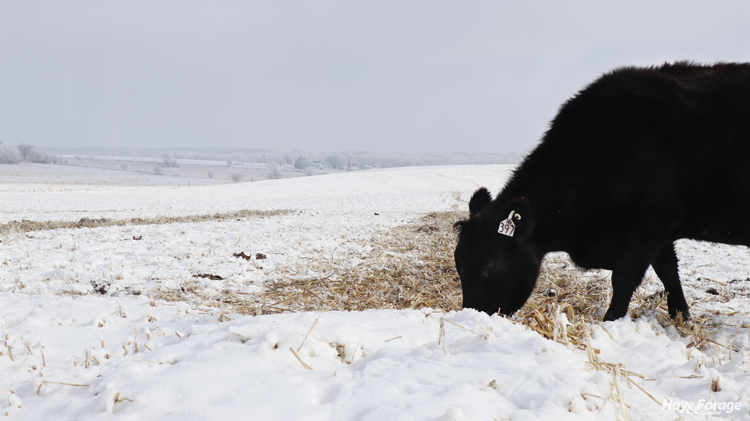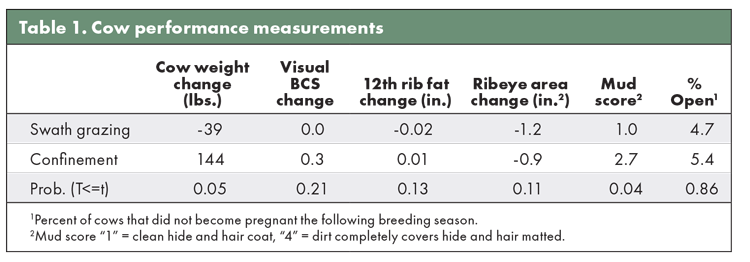
Producers in the Upper Midwest are looking at the tail-end of the growth period for summer annuals, prompting some final harvest decisions. Some may opt to graze forage, while others will mechanically harvest it. There is another option, however, that combines both of those strategies into one: swath grazing.
Swath grazing for winter feed is common in some Northern regions with drier climates, but it is less practiced in the Midwest. The term “swath grazing” simply refers to mowing and raking forage into a swath and grazing the swath of forage rather than picking up the windrows into a bale or making silage.
The most prevalent advantage to swath grazing is less fuel and associated costs of putting up the forage as a stored feed. However, the adaptation of swath grazing in the Upper Midwest has been hindered by a few presumed challenges. These include grazing livestock through snow or ice — particularly when excess moisture causes mud — and managing the farm ground later for the following crop.
At Iowa State University, research over the last four years on two research farms has sought to identify best practices and solve challenges of utilizing a swath grazing strategy in Iowa. In all trials, cattle performance of spring-calving cows that swath grazed was compared to that of their confined herdmates.
Based on forage analysis, the cows grazing swaths did not need to be supplemented, indicating forage quality was sufficient to meet their maintenance needs. Even so, these cows were lighter in body weight at the end of the trials compared to the drylot cows (Table 1).

With that said, swath grazing cows were significantly less muddy, and the resulting calf crop between the groups did not differ in calf birth weight, vigor, or dystocia events (Table 1 and 2). Outside of cattle performance, swath grazing was less labor intensive than managing cows in confinement, even when considering fence moves every three days.
Some of the main lessons researchers learned while exploring swath grazing as a forage management strategy include:
1. Forage quality changed. Forage species and weather forage was in a single- or multi-cut system impacts the ability to maintain forage quality in a swath grazing scenario. For the Iowa State University trials, cattle swath grazed pearl millet and sorghum beginning in mid-December after mowing and raking forage in early December. The mowing date was targeted to reduce the number of freeze-thaw cycles and moisture events that could occur after harvest. From the first killing frost to the time forage was mowed, it experienced the expected nutrient losses associated with moisture.
In the studies, pearl millet tended to maintain forage quality slightly better than sorghum. For cows in their early third trimester of gestation, forage quality in December was about 11% crude protein (CP), 0.36 net energy for maintenance (NEm), and 84 relative forage quality (RFQ), which was sufficient to meet nutrient demands. However, by February, the requirements of cows closer to calving, coupled with some nutrient loss in the forage, dictated a need for supplementation in order to continue swath grazing. For future trials, other forage options, including cool-season forages and mixtures, will be utilized.

2. Forage utilization went up. Cutting as late as possible before the first snow of the season and raking large windrows together improved forage utilization and quality in the wet Midwestern climate by reducing the impact of weathering. Fewer, larger windrows will also allow cows to find feed when snow depth becomes substantial and less material freezes down to the soil surface.
The most efficient forage utilization strategy observed in these studies was to strip graze the swaths, moving the wire perpendicular to the windrows. Researchers moved the wire about every three days with tumble wheel posts. Weather events like snowfall required some flexibility in strip grazing, although cattle were successful at finding swaths under snow and ice. Over three trials, this grazing strategy achieved a utilization rate of approximately 70%, making swath grazing more cost effective than stockpile grazing, even after including the cost of mowing and raking.
3. Labor demands declined. Aside from less manpower and fewer machine hours needed to harvest forage, there were labor savings associated with swath grazing. The treatment including confined cows required labor to deliver hay and bedding and to manage manure the following spring. Researchers tracked employee hours during the trials, and the daily labor commitment for swath grazing cattle was 0.27 hours per cow compared to 0.60 hours per cow in confinement. Additionally, confinement cows required 0.57 tractor hours per cow during the trials.
Farmers can tailor swath grazing management strategies to address individual concerns. To learn more, watch the ISU CROPS TV episode that contains a full interview with a leading research scientist and one farm manager at bit.ly/HFG-swath-grazing.
This article appeared in the August/September 2024 issue of Hay & Forage Grower on pages 10-11.
Not a subscriber? Click to get the print magazine.

